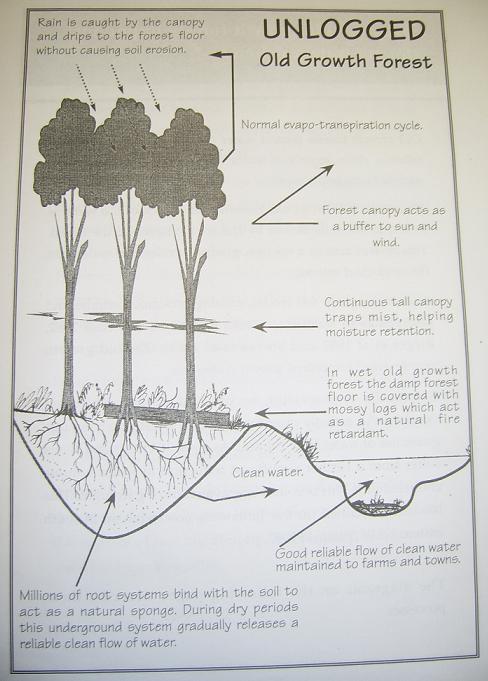These diagrams below first presented in 1995 reveal the process of landscape conversion
of native forest from moist old growth fire resistant type, derived from their closed canopy, to dry sclerophyl
bushfire prone regrowth type.
As long as a moisture rich closed canopy is in place a high density of ground cover remains of moderate
risk and tends to break down quite quickly as well.
The most severe process of logging disruption of the closed forest canopy has been going
on since the advent of high intensity 'integrated logging' for timber but also high proportion of woodchips especially
since the mid 1970ies. This was around the time of the advent of bulldozers, other big machines and modern chainsaws.
Thus even if a small proportion of a forest of say 2 or 3% suffers high intensity logging per
year, after 40 years of patchworking, close to 100% of the moist micro climate will have been destroyed along with
the broken canopy. It will take maybe a century to re establish the moist old growth closed canopy microclimate
across broad areas of forest IF devastating fires don't constantly set the clock back to zero again in a cruel ecological
game of snakes and ladders.
That's how grim the situation has become in large areas of forested south east Australia as a
result of rampaging logging and greed. Even much contemporary national park has been patchwork logged already prior to
reservation in the last 40 years and still to regain closed canopy moisture. Depending on the fire patterns in the future
they may never regain that closed canopy and moisture level.
There are many other factors contributing to bushfire such as ignition sources like arson or naturally
occuring dry lightning. Climate impact of low rainfall also impacts fire intensity and risk. Ground fuel levels are also very
significant.
But what is apparent in the current anxious reflections and research into
how best to deal with the impending catastrophic fires of the futre is that the modern logging industry have been getting
away with environmental murder that promotes mega bushfires. It all follows from breaching the natural water cycle under a
closed canopy:



The diagrams above are based on the following scientific papers:
Cornish PM (1982) The variation of dissolved ion concentration with discharge
in some NSW streams, Forest Hydrologist, Forestry Commission of NSW, The First National Symposium on Forest Hydrology,
eds. EM O'Loughlin & L J Bren, May 1982,
Rieger W A, Olive L J and Burgess J S (1982) Behaviour of sediment concentrations
and solute concentrations in small forested catchments, University of NSW, Department of Geography, FAculty of Military Studies,
The First National Symposium on Forest Hydrology, eds. E M O'Loughlin & L J Bren, May 1982
Stokes R A and Loh I C (1982) 'Sustaining Sensitive Wildlife Within Temperate
Forest Landscapes: Regional Systems of Retained Habitat as a Planning Framework', pages 85-106 in Ecology and Sustainability
of Southern Temperate Ecosystems, eds. Norton T W & Dovers S R, CSIRO 1994.
Wronski E (1993) Tantawangalo research catchments, Change in water yield
after logging, Report to the Forestry Commission of NSW, 1st July 1993
Declaration: The editor/author was
called as witness to the NSW Parliamentary Inquiry, and briefly to the Coronial Inquiry after the summer 1993-4 bushfires,
as a representative of the Wilderness Society in NSW.

